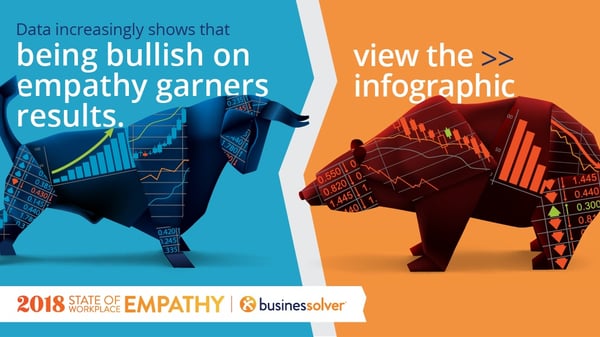 The only certainty business leaders have in today’s market is uncertainty.
The only certainty business leaders have in today’s market is uncertainty.

The war for talent rages, regulatory and commerce changes are a daily occurrence, and competition for customer mindshare – and wallet space – has never been greater. Despite the challenges facing modern business leaders, the answer to unlocking employee engagement and performance and resulting business impact has been right in front of their noses:
It’s hard to believe something so simple and seemingly subjective could have an impact on the growth or decline of a business, but increasingly, data shows that it does – and smart leaders are starting to realize its importance.
Recently, Businessolver conducted its third annual State of Workplace Empathy study, which examines the state of empathy in U.S. workplaces and the impact more – or less – empathy has on employees, HR professionals and the C-suite. The results showed that beyond being the topic du jour, empathy has big business benefits – and the C-suite and other leaders should take notice.
Take a closer look at the bulls and the bears as it pertains to empathy.
The Empathetic Bull
Leaders who make empathy a purposeful part of their businesses report not only better performance from their employees, but also better overall business health. Here are some of the most captivating CEO stats from the study:
- 87% see a direct link between empathy and business performance.
- 80% say the impact empathy has on business is a positive one.
- 42% believe empathy helps drive faster business growth.
- 50% think more empathetic companies make more innovative products and services.
Employees take notice of empathetic employers and are more likely to join – and stay with – organizations that value and exhibit empathy.
- 9 in10 employees said they would be more likely to stay with an empathetic organization.
- 81% of employees (a four-point increase from 2017) said they would be willing to work longer hours for an empathetic employer.
- 60% of employees said they would be willing to take a pay cut to work for an empathetic employer.
The Unempathetic Bear
Leaders of organizations that are less empathetic face not only lower morale, but also the potential loss of valued workforce assets – and business. Don’t believe us? Here are some data points:
- 50% of employees say their CEO is empathetic.
- 92% of CEOs say their organization is empathetic, while 78% of employees rate their employer as empathetic, a signal that a gap in perception still exists between employees and leadership.
- 81% of employees would actually switch companies for equal pay if their potential employer was more empathetic than their current one.
- 79% of employees said they would consider leaving their current organization if that organization became less empathetic.
The Market Outlook
Empathy is becoming a key tool for savvy leaders to have at their disposal as they’re looking to increase employee engagement, retention and business health. The good news? Empathy can be learned, and business leaders looking to reap the benefits of empathy in their workplaces can lead from the top in bringing more empathetic processes, benefits and strategies to the workforce with these three steps:
- Understand where your organization is trending – and lacking – when it comes to empathy. Recognize the challenges facing the workforce and how empathy is – or isn’t – being exhibited.
- Reap the benefits of differences. Embrace the diverse workforce that makes up your organization, and understand how differences in background, gender or age can impact the way employees experience empathy.
- Flex empathy muscles. Learn about the key words and actions that best exhibit empathy. Consider empathy training to boost business performance.
Interested in learning more about how empathy shapes organizations and impacts business bottom line?



.png)